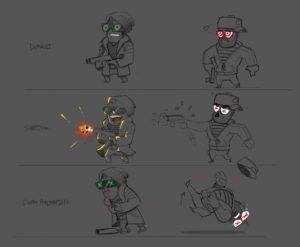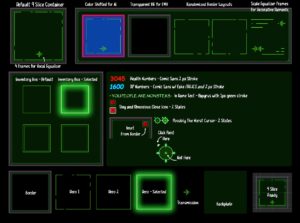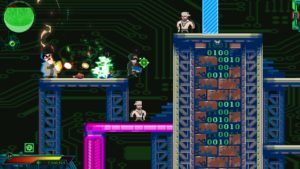With two weeks left in 2020 right before the holiday season, we decided to take a break from some of our usual publishing, development and porting tasks to instead have a little fun. The Akupara Game Jam saw teams of developers, artists, writers, and designers come together to create prototype games and let the imagination of our teams run wild. Today, we’re continuing with our final prototype. You can play the game right now on Itch.io or Gamejolt for free, or you can keep reading to get a little insight from the game’s creative lead, Alyssa Kollgaard.
The Inspiration
The concept of Brain Frame was born from a simple idea, “is it possible to make a game that is purposefully bad, while still being fun?”
Toward the end of 2020, I had taken up watching Twitch mainly as market research for our own efforts with influencers. After integrating into the retro gaming community there, I found that I enjoyed it as a social and creative outlet and began streaming myself, with a focus on cyberpunk and dystopian content.

Some character action designs
After using some cyberpunk chicanery of my own, I was able to dive deep into the world of 90s MS DOS games. They were impossibly hard to go back to as a modern gamer – the UI/UX was woefully inconsistent and outdated, information necessary to progress was nebulous at best, the gameplay was clunky, the dialogue forced. Yet there was something eternally charming and nostalgic about the experience – I loved to hate these games, and I found myself having more fun with them than most modern titles. Especially the FMV games, which saw a brief heyday in the early 90s and then fell out of favor almost as quickly as they began. They were a relatively inconsequential moment in the lifecycle of video games, yet there is still an air of mystery and mythos around the genre. Playing through these titles reminded me of my early days as a gamer, while simultaneously serving as a fascinating history lesson in game development and a reminder of how far we’ve come as an industry.
On top of my own experiences with MS DOS and Sega CD retro gaming, I’d been watching speedrunners optimize their gameplay on older titles that – honestly – really didn’t hold up to modern design sensibilities or standards. Seeing the ways in which competitive players utilized glitches and overcame game issues in retro Metroidvanias and platformers was very intriguing – could we design a game that intentionally integrated the glitches into the actual design? Could we do things we knew went against modern practices in a way that felt fun and endearing? Could we create an homage to this era of gaming that would appeal to current gamers, speedrunners and streamers?
Before the Game Jam, I posted this question to our designer, Matt. “Well, you could implement some roguelike elements.” PERFECT. The missing detail to tie it all together.
The Execution
Luckily, I’m not the only sadist on the team at Akupara, When it was presented as an idea in the Game Jam, several other team members expressed excitement. After splitting into teams based on project interest and skillsets, we were lucky in that most of us on team Bram Frame had previously established rapport and personal interest in this genre (and that most of us actually could encompass multiple roles on a small team). Joey, our UI and character artist, even designed all my Twitch branding and emotes in a similar aesthetic to Brain Frame. Somehow he managed to subvert all his knowledge of user flow and interfacing to create some truly frustrating player interactions. Cat, our audio engineer and composer is well-known for his extremely A E S T H E T I C vaporwave chiptunes and brought some gritty 90s inspiration to the music and SFX that helped bring depth to everyone’s assets. Matt, one of the most versatile designers in the entire industry brought cohesion to the project and created a base game concept for the roguelike elements to layer on top of. His main gig is as a 2D artist, so he also did all our environment art (his first time doing pixel art for an Akupara project, in fact). Kyle, our writer, brought the perfect amount of cheese and purpose to both the script and portrayal of the protagonist Vincent Villenzi. Finally Addison, our rockstar engineer somehow managed to tie all our assets and ideas in a shippable project. I served as producer and vision holder and got to use some of my video editing skills (a hobby I picked up earlier in quarantine) to bring some FMV flair to the project. Brain Frame dream team. A++ would game jam again.

A mockup of Brainframe’s UI
After Matt created the initial design pitch – a MegaMan X style platformer/shooter – our team all submitted ideas for reverse roguelike elements. Essentially, these would be things that would make the gameplay harder the more you progressed, and would have stacking effects to create challenging randomized and player-controlled loadouts. We did a kick off meeting where we each outlined how long we estimated each task would take to complete, including asset creation and implementation, and then did triage based on our favorites and what components would get us the most bang for our buck.
Cyberpunk 90s games were not only the inspiration for the project, but also the perfect narrative wrapper for why you’d be encountering all of these debuffs – why, they are viruses sent to you by an enemy hacker, of course! We compiled some inspiration images into a Pinterest board, got tasks tracking in a Trello board and got to work.
Amazingly, even though a lot of our elements were done independently from each other, the combined aesthetic was very cohesive. The 2D environments were pixel art, and our characters illustrated, but they still worked. Our VFX, our color palettes, our video assets were all disjointed but totally in keeping with one another. They were ugly and beautiful at the same time. The SFX and music brought in elements that haven’t been heard in games in 20+ years, and it was a joy to be reminded of them. It was definitely a game created in 2020, but the inspiration was very visible – this was plainly a love letter from all of us to the games of our youth.
The FMV sequences were especially fun to work on, as their creation involved quick turnaround on cross collaboration – writing, acting, video editing and audio. We pulled in a couple of our partners to help act, and even had a cameo from one of the other game jam teams.
To be honest, most of us probably went over our 15 hours on the project because we all were having so much fun. It was a wonderful way to close out a rough year, being creative for creativity’s sake. Although our source of inspiration was objectively bad we turned it into something wonderful that we all loved. That’s exactly what we all needed.

A screenshot from an early build
The Continuation
There are a lot of places we could go with Brain Frame in the future. The obvious answer is more disturbances, as a wide range of randomization for builds is the core of a roguelike experience. Obviously we’d want more levels and environments, smarter AI with more enemy variations and behaviors, and deeper implementation of the UI elements. We’d likely add in pickups, more soundtrack songs, and of course more FMVs. Maybe even a couple friendly NPCs to help you on your way. We’d also like there to be a final boss battle at the end of each environment (maybe 5 environments/bosses/levels total) – we have the asset for one, but we didn’t get around to putting it in the build. We have practically all the UI we’d need for a game, but I’m sure we could think of more obtuse and annoying details to add on here. The level layouts themselves would randomize instead of being a set path, and the FMVs would trigger at the end of room clears so they’d be more connected to gameplay.
Regardless, the core of what we want the game to be is there and we think it is a pretty fun and interesting twist on a genre. 🙂 We hope you all got some enjoyment out of the experience as well!
If you want to hear more about the development of Brain Frame, I sat down with Buddy to talk about it for the Akupara Podcast! Give it a listen!
